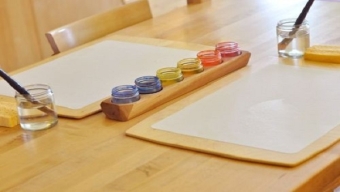I suggest using masonite for painting boards. I have tried several times and finally perfected the process.
Here are the tricks:
- purchase masonite that is about 1/4 to 3/8 inch thick – the thin stuff will warp, guaranteed
- buy the kind that has a nice smooth surface on both sides
- *before* you use the boards at all, finish them with a beeswax polish.
You can use commercial beeswax wooden polish (Clapham’s is one, I think) or you can make your own by heating some beeswax in a baby food jar set in hot water over low heat. Add approximately the same amount of olive oil and heat until the beeswax melts – stir it together well with a popsicle stick or something and let it cool. When it cools it should be soft enough that you can break off a bit and squish it in your fingers, re melt and adjust the proportions if necessary.
Rub the beeswax mixture generously on the board (both sides and edges) and rub it in well (my kids loved to help with this – it’s messy but smells wonderful). Let the board sit in a sunny place for a few hours for the oils to really soak into the wood, then rub off any excess with a lint-free rag.
The heavy boards that I prepared this way have lasted through dozens of very wet! painting sessions so far and show no sign of warping, and I have never had a problem with the paint not cleaning off them. If they seemed to lose their finish I could reapply it but I haven’t needed to yet.
Hope this helps someone. I was glad to finally figure out how to do this, and it was so easy and inexpensive that I can have lots of nice large painting boards so we are able to paint when friends are over, too.
Copyright 2002 Doreen Hyndman, Used with permission.





















